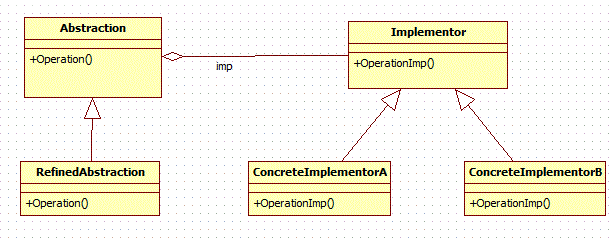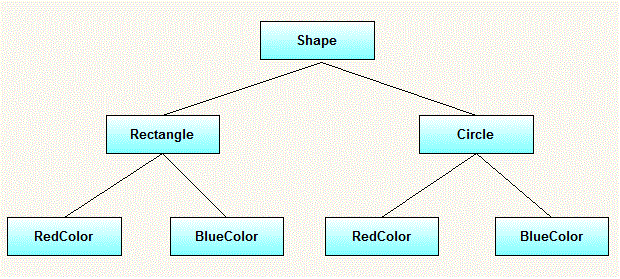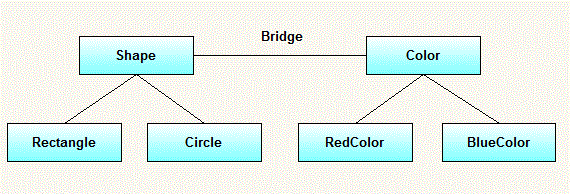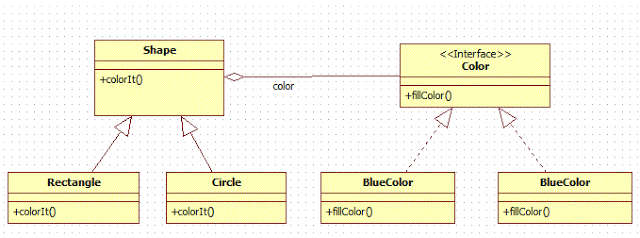Table of Contents
As stated by Gof:
“Decouple an abstraction from its implementation so that the two can vary independently”.When there are inheritance hierarchies in both interface and implementation then you loose coupling because of interdependence.In other words,Decoupling interface from implementation and hiding implementation detail of abstraction from client is main objectives of bridge design pattern.
This is our implementor class.
Color.java(Implementor):
BlueColor.java(ConcreteImplementor):
BridgeDesignPatternMain.java:
“Decouple an abstraction from its implementation so that the two can vary independently”.When there are inheritance hierarchies in both interface and implementation then you loose coupling because of interdependence.In other words,Decoupling interface from implementation and hiding implementation detail of abstraction from client is main objectives of bridge design pattern.
Also known as:
Handle/Body
UML diagram of generic bridge design pattern:
Elements:
- Abstraction
- defines the abstraction’ s interface.
- maintain reference to object of type implementor.
- RefinedAbstraction
- extends the interface defined by abstraction.
- Implementor
- defines the interface for implementation classes.This interface doesn’t have to correspond exactly to abstraction’s interface;in fact the two interfaces can be quite different.Typically the implementor interface provides only primitive operations,and abstraction defines higher-level operations based on these primitives.
- ConcreteImplementor
- implements the implementor interface and defines its concrete implementation.
When to use it:
- Abstraction and implementation should be bound at compile time.
- Both abstraction and implementation can have different hierarchies independently.You want to extend both hierarchies by subclassing.
- Changes in implementation should have no impact on abstraction.
- If you want to hide implementation of abstraction from client.
- Best use when you have multiple implementation.
WorkFlow:
Abstaction forwards client request to its implementor object.
Example:
Before Applying bridge design pattern:
After applying bridge design pattern:
My example includes following elements:
- Shape(Abstraction)
- Rectangle(RefinedAbstraction)
- Circle(RefinedAbstraction)
- Color(Implementor)
- RedColor(ConcreteImplementor)
- BlueColor(ConcreteImplementor)
Java code for all above classes:
We have two inheritance hierarchies here.i.e Shape and Color.Now with help of bridge design pattern both can vary independently.
This is our abstraction class.
Shape.java(Abstraction):
|
1 2 3 4 5 6 7 8 9 10 11 12 13 |
package org.arpit.javapostsforlearning.designpatterns; abstract class Shape { Color color; Shape(Color color) { this.color=color; } abstract public void colorIt(); } |
Rectangle.java(RefinedAbstraction):
|
1 2 3 4 5 6 7 8 9 10 11 12 13 14 15 |
package org.arpit.javapostsforlearning.designpatterns; public class Rectangle extends Shape{ Rectangle(Color color) { super(color); } public void colorIt() { System.out.print("Rectangle filled with "); color.fillColor(); } } |
Circle.java(RefinedAbstraction):
|
1 2 3 4 5 6 7 8 9 10 11 12 13 14 15 |
package org.arpit.javapostsforlearning.designpatterns; public class Circle extends Shape{ Circle(Color color) { super(color); } public void colorIt() { System.out.print("Circle filled with "); color.fillColor(); } } |
This is our implementor class.
Color.java(Implementor):
|
1 2 3 4 5 6 7 8 |
package org.arpit.javapostsforlearning.designpatterns; public interface Color { public void fillColor(); } |
RedColor.java(ConcreteImplementor):
|
1 2 3 4 5 6 7 8 9 10 |
package org.arpit.javapostsforlearning.designpatterns; public class RedColor implements Color{ public void fillColor() { System.out.println("red color"); } } |
|
1 2 3 4 5 6 7 8 9 10 |
package org.arpit.javapostsforlearning.designpatterns; public class BlueColor implements Color{ public void fillColor() { System.out.println("blue color"); } } |
|
1 2 3 4 5 6 7 8 9 10 11 12 13 14 |
package org.arpit.javapostsforlearning.designpatterns; public class BridgeDesignPatternMain { public static void main(String[] args) { Shape s1=new Rectangle(new RedColor()); s1.colorIt(); Shape s2=new Circle(new BlueColor()); s2.colorIt(); } } |
Output:
|
1 2 3 4 |
Rectangle filled with red color Circle filled with blue color |
Related patterns:
An Abstract Factory can create and configure a particular bridge.
The Adapter design pattern convert interface of a class ito another interface clients expects.It is usually applied to system after they are designed.Bridge on other hand is used up-front in a design to let abstractions and implementation vary independently.
Was this post helpful?
Let us know if this post was helpful. Feedbacks are monitored on daily basis. Please do provide feedback as that\'s the only way to improve.






